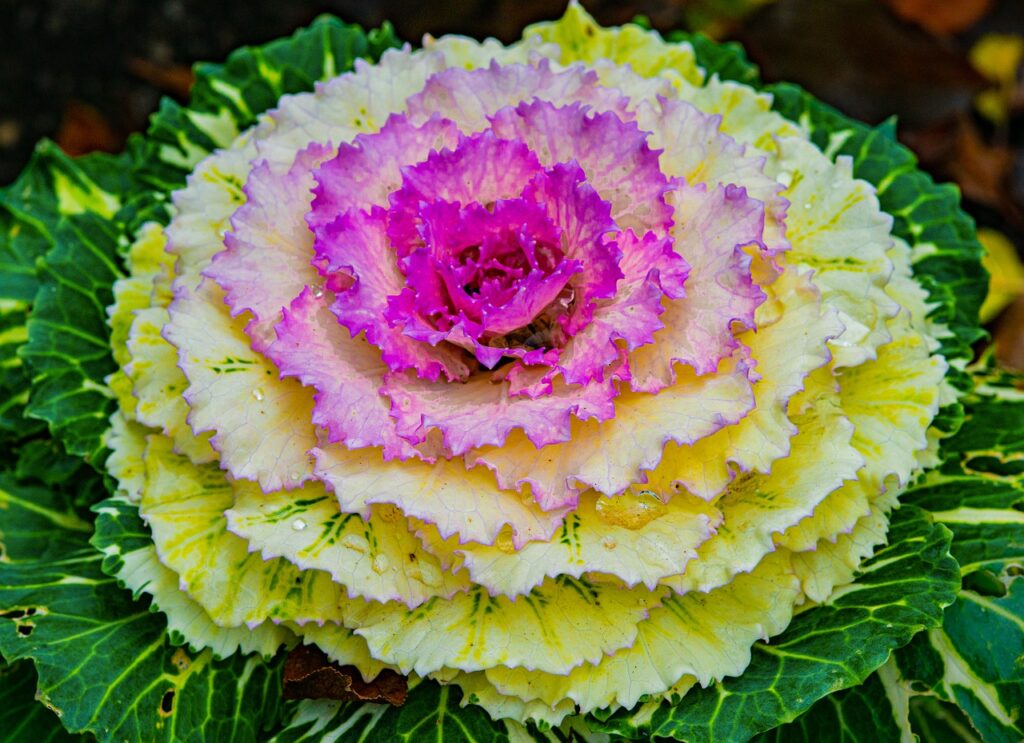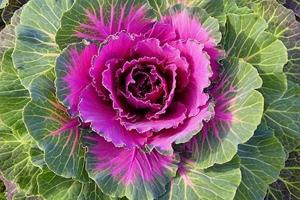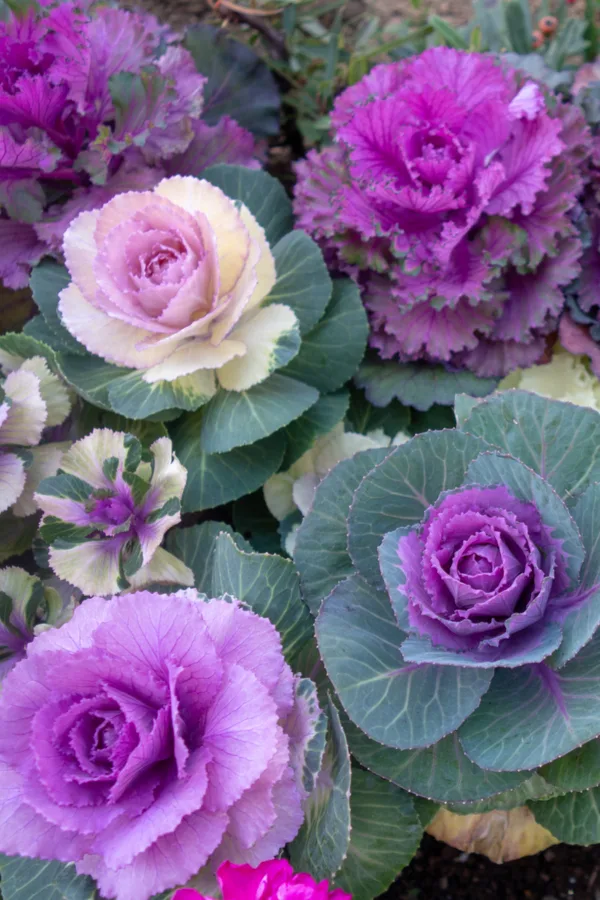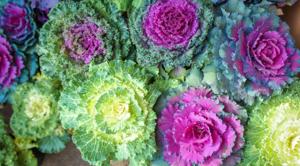Easy Steps to Grow Beautiful Ornamental Cabbage and Kale

Introduction
Ornamental cabbage and kale have emerged as stunning additions to modern landscaping. They offer vibrant colors and interesting textures when many other plants have faded. These varieties are members of the same species as (Brassica oleracea). They are bred for their foliage patterns and colors rather than taste.
Gardeners choose these plants for their ability to provide visual interest. They are hardy and low-maintenance plants. They are used in containers, borders, or focal points in the garden. Ornamental cabbage and kale add a unique dimension to any landscape design.
What Are Ornamental Cabbage and Kale?
Definition and Botanical Classification
Ornamental cabbage and kale belong to the Brassicaceae family. They are Brassica oleracea var. acephala. Regular cabbage forms a head (var. capitata). The ornamental varieties create open rosettes of leaves, showcasing their colors and patterns.
History and Development
Decorative varieties were first developed in Japan. They are known as “habotan”. Horticulturists have created dramatic color combinations and leaf patterns. “Habotan” is popular worldwide for fall and winter gardens.
Key Differences Between Ornamental Cabbage vs. Ornamental Kale
Ornamental cabbage and kale have distinct characteristics:
Ornamental Cabbage:
- Smooth, broad leaves with wavy edges
- Forms a more rounded head
- Colors often appear in distinct zones
- Generally larger than ornamental kale
Ornamental Kale:
- Cut, frilly, or ruffled leaves
- More upright growth habit
- Colors tend to be more intense
- Often more cold-hardy than cabbage varieties
Popular Varieties and Cultivars
Ornamental Cabbage Varieties:
- ‘Color Up’ series – compact plants with pink, white, or red centers
- ‘Tokyo’ series – large heads with dramatic color contrast
- ‘Pigeon’ series – rounded heads with intense colors
Ornamental Kale Varieties:
- ‘Nagoya’ series – fringed leaves in red, white, or rose
- ‘Peacock’ series – feathered leaves with vibrant colors
- ‘Redbor’ – tall variety with deep purple leaves
- ‘Chidori’ series – curled leaves with intense color
Benefits of Growing Ornamental Cabbage and Kale
Visual Appeal
- Provides striking color when most plants are dormant
- Creates interesting textural contrast in the garden
- Offers a range of colors from white to pink, purple, and deep red
- Maintains appearance throughout the cool season
Cold-Weather Tolerance
- Thrives in temperatures between 45°F and 60°F (7°C to 16°C)
- Colors intensify after frost exposure
- Can survive temperatures down to 5°F (-15°C)
- Provides garden interest through winter in many regions
Long-lasting Display
- Plants last 3-6 months in cool weather
- Color intensifies as temperatures drop
- Maintains form and structure throughout the season
- Can changed yearly for continuous display
Low Maintenance Requirements
- Resistant to many common garden pests
- Requires minimal pruning
- Drought-tolerant once established
- Few fertilizer requirements after planting
Versatility in Landscaping
- Excellent for container gardens
- Effective as border plants
- Creates stunning mass plantings
- Works well in mixed flower beds
- Ideal for commercial landscapes

Growing Conditions for Ornamental Cabbage and Kale
Climate Requirements
Optimal Temperature Range:
- Best growth: 45°F to 60°F (7°C to 16°C)
- Color development: Below 60°F (16°C)
- Maximum heat tolerance: 80°F (27°C)
- Minimum temperature: 5°F (-15°C)
Best Growing Zones:
- USDA Hardiness Zones 2-9
- Optimal performance in Zones 4-7
- Can be grown as annuals in warmer zones
- May need protection in extreme conditions
Seasonal Timing for Planting:
- Fall planting: 6-8 weeks before first frost
- Spring planting: Early spring as soon as soil can be worked
- Summer planting is not recommended due to the heat
- Consider local frost dates when planning
Cold Hardiness:
- Survives light freezes without protection
- Colors intensify after frost exposure
- May need protection below 5°F (-15°C)
- Snow coverage provides natural insulation
Soil Requirements
Soil Type and pH:
- Well-draining, rich soil
- pH range: 6.0-7.0
- High organic matter content
- Loamy texture preferred
Drainage Needs:
- Excellent drainage essential
- Avoid waterlogged conditions
- Raised beds beneficial in heavy soils
- Container growing requires drainage holes
Soil Preparation Tips:
- Incorporate 2-3 inches of compost
- Till to 12 inches depth
- Remove rocks and debris
- Level soil surface before planting
Fertilizer Recommendations:
- Pre-planting: balanced NPK (10-10-10)
- Light feeding during growth
- Avoid high nitrogen
- Side-dress with compost monthly
Light Requirements
Sun Exposure Needs:
- Full sun optimal for the best growth and color
- At least 6 hours of direct sunlight daily
- Morning sun preferred in warmer climates
- More sun exposure intensifies leaf coloration
Shade Tolerance:
- Can tolerate partial shade
- Avoid deep shade locations
- May become leggy with insufficient light
- Color development reduced in too much shade
Position in Garden:
- South or west-facing locations ideal
- Protect from harsh afternoon sun in hot climates
- Consider winter sun patterns when planting
- Allow space for adequate air circulation

Planting Guide
When to Plant
Spring Planting Timeline:
- Sow seeds indoors 4-6 weeks before the last frost
- Transplant when soil temperature reaches 50°F (10°C)
- Harden off seedlings for 7-10 days
- Plant early for establishment before the heat
Fall Planting Timeline:
- Start seeds 12-14 weeks before the first frost
- Transplant 6-8 weeks before first frost
- Allow time for root development
- Plant when night temperatures are consistently below 60°F (16°C)
Regional Considerations:
- Adjust timing based on local climate
- Consider microclimate effects
- Track local weather patterns
- Plan for seasonal temperature variations
How to Plant
Spacing Requirements:
- Large varieties: 18-24 inches apart
- Compact varieties: 12-15 inches apart
- Row spacing: 24-30 inches
- Container spacing: One plant per 12-inch pot
Planting Depth:
- Set plants at same depth as nursery container
- Seeds: ¼ inch deep
- Firm soil around roots
- Create a shallow basin for watering
Transplanting Tips:
- Water before transplanting
- Handle plants by root ball
- Avoid disturbing roots
- Plant on cloudy days if possible
- Water immediately after planting
Container Planting Instructions:
- Use containers at least 12 inches deep
- Ensure adequate drainage holes
- Use quality potting mix
- Leave 1 inch at the top for watering
- Consider container material for winter durability
Care and Maintenance
Watering
Frequency:
- Check soil moisture daily
- Water when the top inch is dry
- Reduce frequency in cool weather
- Increase during the establishment period
Amount:
- 1-1.5 inches of water per week
- Adjust based on rainfall
- More in containers
- Less in cool, humid conditions
Watering Techniques:
- Water at soil level
- Avoid wetting leaves
- Morning watering preferred
- Use soaker hoses for large plantings
- Check drainage
Common Watering Mistakes:
- Overwatering in cool weather
- Insufficient water during establishment
- Irregular watering schedule
- Watering late in day
- Poor drainage management
Fertilizing
Types of Fertilizers:
- Balanced (10-10-10) at planting
- Low nitrogen during growth
- Water-soluble for containers
- Organic options:
- Fish emulsion
- Seaweed extract
- Compost tea
Application Schedule:
- At planting time
- Every 4-6 weeks during growth
- Reduce in winter
- Stop fertilizing when heads form
Amount to Use:
- Follow package directions
- Reduce by half for containers
- Side-dress 2-3 inches from stem
- Avoid over-fertilizing
Signs of Nutrient Deficiency:
- Yellowing leaves (nitrogen)
- Purple leaves (phosphorus)
- Brown leaf edges (potassium)
- Stunted growth
- Poor color development
Common Problems and Solutions
Pest Management:
Cabbage Worms:
- Identify by small green caterpillars
- Hand-pick when visible
- Use Bt (Bacillus thuringiensis)
- Install row covers
- Check regularly
Aphids:
- Check the undersides of leaves
- Spray with a strong water stream
- Use insecticidal soap
- Encourage beneficial insects
- Maintain plant vigor
Other Common Pests:
- Slugs and snails
- Root maggots
- Flea beetles
- Cutworms
- Prevention methods:
- Clean cultivation
- Proper spacing
- Regular monitoring
- Companion planting
Disease Prevention and Treatment:
Root Rot:
- Improve drainage
- Reduce watering
- Remove affected plants
- Rotate planting areas
- Use raised beds in prone areas
Fungal Issues:
- Powdery mildew
- Black spot
- Prevention:
- Good air circulation
- Morning watering
- Proper spacing
- Clean garden practices
Bacterial Problems:
- Black rot
- Bacterial leaf spot
- Prevention:
- Clean tools
- Avoid overhead watering
- Remove infected leaves
- Crop rotation
Troubleshooting Growth Issues:
- Leggy plants: Insufficient light
- Poor color: Too warm or low in nutrients
- Splitting heads: Irregular watering
- Slow growth: Poor soil or temperature
- Leaf damage: Environmental stress

Design Ideas and Landscaping with Ornamental Cabbage and Kale
Garden Design
Color Combinations:
- Purple kale with white cabbage
- Pink centers paired with silver foliage plants
- Deep green borders around colorful centers
- Monochromatic designs using single colors
- Color echoing with companion plants
Companion Plants:
- Flowering Plants:
- Pansies
- Violas
- Chrysanthemums
- Snapdragons
- Dusty Miller
- Ornamental Grasses:
- Blue Fescue
- Japanese Forest Grass
- Purple Fountain Grass
- Other Winter Interest:
- Heuchera
- Winter Heath
- Evergreen Shrubs
Border Designs:
- Front of border placement
- Alternating colors for rhythm
- Repeated patterns
- Graduated heights
- Formal vs. informal arrangements:
- Formal: Symmetrical patterns
- Informal: Flowing groups
- Mixed: Balanced composition
Mass Plantings:
- Large-scale impact
- Single variety displays
- Color blocking techniques
- Spacing for maturity
- Maintenance considerations
Container Gardens
Container Selection:
- Size Requirements:
- Minimum 12 inches deep
- 12-15 inches diameter per plant
- Larger for many plants
- Material Considerations:
- Frost-resistant pottery
- Fiber cement
- Heavy-duty plastic
- Metal containers
- Wood planters
- Drainage:
- Many drainage holes
- Elevated feet
- Interior gravel layer
Mixed Container Designs:
- Thriller, Filler, Spiller Approach:
- Thriller: Tall kale varieties
- Filler: Compact cabbage
- Spiller: Trailing ivy or vinca
- Color Schemes:
- Monochromatic
- Complementary colors
- Analogous combinations
- Texture Combinations:
- Smooth and ruffled leaves
- Fine and bold textures
- Varying heights
Patio and Deck Displays:
- Grouping Strategies:
- Odd-numbered clusters
- Varying heights
- Unified color schemes
- Location Considerations:
- Sun exposure
- Wind protection
- Visibility from indoors
- Traffic patterns
- Maintenance Access:
- Watering ease
- Plant inspection
- Seasonal transitions
Winter Container Arrangements:
- Cold-Hardy Combinations:
- Evergreen branches
- Winter berries
- Ornamental grasses
- Protection Methods:
- Insulating materials
- Root zone protection
- Windscreens
- Design Longevity:
- Extended season interest
- Replacement strategies
- Transition planning

Seasonal Care Tips
Fall Care
Preparing for Display:
- Timing:
- Plant 6-8 weeks before frost
- Allow for establishment
- Check weather patterns
- Soil Preparation:
- Fresh compost addition
- pH adjustment if needed
- Drainage improvement
- Initial Care:
- Regular watering
- Light fertilization
- Pest monitoring
Protection Methods:
- Mulching:
- 2-3 inches depth
- Keep away from stems
- Natural materials
- Weather Protection:
- Frost cloth ready
- Windbreaks
- Emergency covers
- Pest Prevention:
- Regular inspection
- Preventive treatments
- Clean cultivation
Maintenance Schedule:
- Weekly Tasks:
- Inspect for pests
- Check soil moisture
- Remove damaged leaves
- Monthly Tasks:
- Fertilizer assessment
- Mulch check
- Growth evaluation
- Seasonal Tasks:
- Photography documentation
- Planning for next season
- Supply inventory
Winter Care
Cold Protection:
- Temperature Monitoring:
- Weather forecasts
- Microclimate awareness
- Critical temperature points
- Protection Methods:
- Row covers
- Cold frames
- Mulch change
- Wind barriers
- Emergency Measures:
- Temporary covers
- Heat sources
- Infrastructure check
Snow Management:
- Snow Load:
- Gentle removal
- Support structures
- Damage prevention
- Ice Control:
- Avoid salt exposure
- Natural deicing methods
- Drainage maintenance
- Plant Protection:
- Physical barriers
- Natural snow insulation
- Recovery strategies
Winter Display Maintenance:
- Regular Inspection:
- Structural integrity
- Color development
- Health assessment
- Cleaning:
- Remove dead leaves
- Clear debris
- Maintain appearance
- Documentation:
- Success rates
- Problem areas
- Improvement notes
Spring Transition
Removal Timing:
- Temperature Indicators:
- Consistent warmth
- Soil temperature
- Growth patterns
- Plant Conditions:
- Bolting signs
- Quality assessment
- Replacement needs
- Garden Schedule:
- Spring planting timeline
- Soil preparation
- Next season planning
Replacement Planning:
- Spring Options:
- Cool-season annuals
- Perennial installation
- Vegetable gardens
- Design Continuity:
- Color schemes
- Height considerations
- Seasonal flow
Garden Bed Preparation:
- Soil Improvement:
- Organic matter addition
- pH testing
- Nutrient assessment
- Bed Renovation:
- Edge restoration
- Grade change
- Drainage check
- Future Planning:
- Crop rotation
- Design modifications
- Maintenance adjustments

Frequently Asked Questions about Ornamental Cabbage and Kale
Are ornamental cabbage and kale edible?
Ornamental varieties are not bred for taste. They tend to be tougher and bittier than their culinary counterparts. They’re often treated with ornamental-grade fertilizers and pesticides not suitable for food crops. For eating, it’s better to grow varieties bred for consumption.
How long do they last?
Ornamental cabbage and kale can last 3-6 months in cool weather. Their display period depends on:
- Temperature conditions
- Planting time
- Care quality
- Variety selection: They usually maintain peak appearance from fall through winter. In early spring they begin to flower.
Why aren’t my plants developing color?
Poor color development usually results from:
- Temperatures above 60°F (16°C)
- Insufficient sunlight
- Nutrient deficiencies
- Improper variety selection: Color intensifies with exposure to cold temperatures and full sun. For best color development, allow 2-3 weeks of cool weather.
Can they survive frost?
Yes, ornamental cabbage and kale are frost-hardy plants that can survive temperatures down to 5°F (-15°C). Frost exposure often enhances their color intensity. They may need protection in:
- Extreme cold snaps
- Windy conditions
- Freeze-thaw cycles
- Areas with minimal snow cover
Do they come back every year?
No, ornamental cabbage and kale are grown as annuals. They:
- Complete their lifecycle in one growing season
- Will bolt and flower in spring
- Don’t regrow after flowering
- Need replanting each season
- Gardeners collect seeds, but hybrid varieties won’t breed true to type.
How big do they get?
Size varies by variety:
- Height: 12-18 inches typically
- Width: 12-24 inches
- Compact varieties: 8-12 inches
- Large varieties: up to 24 inches Factors affecting size include:
- Growing conditions
- Spacing
- Variety selection
- Care quality
When should I remove them?
Remove plants when:
- They begin to flower
- Show significant decline
- Spring temperatures consistently rise
- Planning spring garden transitions Typical removal times:
- Early to mid-spring
- Before major garden renovations
- When replacement plants are ready
Can they be grown indoors?
Growing indoors is possible but challenging:
- Requirements:
- Bright, direct sunlight
- Cool temperatures
- Good air circulation
- Proper container size
- Challenges:
- Limited light in winter
- Indoor heating issues
- Space constraints
- Pest management’s Best results come from:
- South-facing windows
- Cool rooms (55-65°F)
- Supplemental lighting
- Regular monitoring

Conclusion
Summary of Key Points
Ornamental cabbage and kale offer advantages for cool-season gardens:
- Striking visual interest when other plants decline
- Exceptional cold hardiness
- Versatile design applications
- Low maintenance requirements
- Long-lasting display potential
Success depends on:
- Proper timing of planting
- Appropriate growing conditions
- Regular maintenance
- Understanding seasonal needs
- Proper variety selection
Final Tips for Success
- Planning:
- Choose appropriate varieties for your climate
- Time planting for optimal growth
- Consider companion plantings
- Plan for seasonal transitions
- Culture:
- Provide well-draining soil
- Ensure adequate sunlight
- Maintain consistent moisture
- Watch for pests and diseases
- Design:
- Use in mixed containers
- Create dramatic mass plantings
- Combine with complementary plants
- Consider seasonal color changes
- Maintenance:
- Regular monitoring
- Prompt problem response
- Seasonal adjustments
- Documentation for future planning
With care ornamental cabbage and kale can provide stunning garden displays. They add unique texture and color when other plants have faded. Their cold hardiness makes them invaluable additions to any garden. These plants offer extended seasonal interest.
Success with these plants improves with experience. Keeping records of what works best in your specific growing conditions will help.